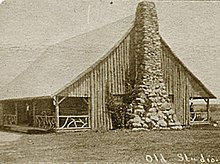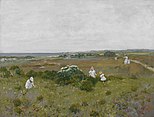Shinnecock Hills Summer School of Art

Multi tool use
 Art Studio at Shinnecock Hills Summer School of Art | |
| Formation | 1891 |
|---|---|
| Founder | Janet Ralston Chase Hoyt |
| Extinction | 1902 (1902) |
| Purpose | summer art school devoted to plein air painting |
| Location |
|
Director | William Merritt Chase |
The Shinnecock Hills Summer School of Art was summer school of art in Shinnecock Hills, Long Island that existed from 1891 to 1902. The director was William Merritt Chase. The school was one of the first and most popular plein air painting schools in America.[1] During the time Chase was teaching at Shinnecock Hills he painted some of his most notable Impressionist landscapes.
Contents
1 History
2 Buildings
3 Location
4 References
5 Gallery
6 Notable alumni
7 Further reading
History

Chase teaching at the Shinnecock Hills Summer School of Art
Mrs. William Hoyt (Janet Ralston Chase Hoyt) was a New York philanthropist, developer, and artist.[2] She was a summer resident of Southampton, Long Island and had the desire to start a summer art school providing training in open air landscape painting. She asked Chase to teach at the school. At that time Chase was well-regarded as a painter and a teacher. Hoyt also approached fellow Southampton residents Mrs. Henry Kirke Porter (Annie de Gamp Perrot Hegeman Porter) and Samuel Longstreth Parrish to provide financial support. Porter and Parrish provided the land for a large studio.[3] The land abutting the studio, named the "Art Village", had residential cottages.[2]
The first classes were taught in the summer of 1891 before any construction on the studio or the "Art Village". The school rented an old farmhouse and Chase lived at the Shinncock Inn. The students could stay in Samuel Parrish's home or rent rooms in the area. The first summer was a success. By the summer of 1892 there were more than 100 students enrolled[4] The studio and several cottages were completed, and classes were held at the location where it would continue to operated until its closure in 1902.[2]
Chase taught for two days each week. On Mondays he would hold a studio critique, reviewing the student work from the previous week. On Tuesdays Chase would set up his easel in the Shinncock Hills and paint while providing instruction. Chase encouraged his students to paint in the bright light, omitting preliminary sketches, and matching the colors painted to those observed. Students spent the rest of the week working on their paintings, either outside in the dunes, or in the studio during inclement weather.[3] Classes were taught by other artists, for example Lydia Field Emmet taught beginning drawing.[2]
In 1897 the school made a change in the name and administration due to Chase severing his ties with the school's co-sponsor, the Brooklyn Institute. The name was changed to the Shinnecock School of Art for Men and Women. Chase became the president, with Charles Webster Hawthorne and Douglas John Connah serving as administrators.[2]
From 1891 to 1902 about 1,000 students studied at the Shinnecock Hills Summer School of Art.[5]
The school was successful, but Chase returned to spending his summers in Europe and the school closed in 1902.[2]

Students at Shinnecock Hills Summer School of Art, ca. 1895
Buildings

Map of the Art Village Situated at Shinnecock Hills
The Art Studio was at the northeastern edge of the property, built with an exterior of log slabs.. The interior was one large workspace, with a large 2-sided easel in the center of the room.[2]
The "Art Village" had cottages that were built by the individual owners of the residential lots. They were built in a variety of rustic styles, including Colonial Revival and early Arts and Crafts, and mostly clad in natural shingles. Several of the cottages were designed by former students Grosvenor Atterbury and Katharine Budd. The cottages were often rented out to students.[2] The "Art Village" was designated as a Hamlet Heritage Resource Area by the Southampton Town Board in 2012.[6]
A few miles down the road a summer home and studio were built for Chase and his family. They were designed by Stanford White.[3]
Location
The Shinnecock Hills Summer School of Art was located on the south fork of Long Island, New York in Shinnecock Hills just west of Southampton. At the time the school was started, the 4,000 acres of Shinnecock Hills was being developed by the Long Island Improvement Company (LIIC) which was a subsidiary of the Long Island Railroad. The school was close to the Shinnecock Hills station located on the Sag Harbor branch of the Long Island Railroad, about three hours by rail from New York City. The LIIC sold the land for the studio to benefactors Porter and Parrish. The LIIC also sold the land for the adjacent 21 residential lots (the "Art Village") to private individuals, most of whom were associated with the school. The Hoyt family, the Parrish family, and Grosvenor Atterbury purchased multiple lots.[2]
References
^ Meisler, Stanley (February 2001). "William Merritt Chase: Praised by critics, admired by colleagues and respected by students, the distinguished 19th-century artist produced paintings and pastels of gentle beauty". Smithsonian/General OneFile: 84. Retrieved 23 July 2018..mw-parser-output cite.citationfont-style:inherit.mw-parser-output .citation qquotes:"""""""'""'".mw-parser-output .citation .cs1-lock-free abackground:url("//upload.wikimedia.org/wikipedia/commons/thumb/6/65/Lock-green.svg/9px-Lock-green.svg.png")no-repeat;background-position:right .1em center.mw-parser-output .citation .cs1-lock-limited a,.mw-parser-output .citation .cs1-lock-registration abackground:url("//upload.wikimedia.org/wikipedia/commons/thumb/d/d6/Lock-gray-alt-2.svg/9px-Lock-gray-alt-2.svg.png")no-repeat;background-position:right .1em center.mw-parser-output .citation .cs1-lock-subscription abackground:url("//upload.wikimedia.org/wikipedia/commons/thumb/a/aa/Lock-red-alt-2.svg/9px-Lock-red-alt-2.svg.png")no-repeat;background-position:right .1em center.mw-parser-output .cs1-subscription,.mw-parser-output .cs1-registrationcolor:#555.mw-parser-output .cs1-subscription span,.mw-parser-output .cs1-registration spanborder-bottom:1px dotted;cursor:help.mw-parser-output .cs1-ws-icon abackground:url("//upload.wikimedia.org/wikipedia/commons/thumb/4/4c/Wikisource-logo.svg/12px-Wikisource-logo.svg.png")no-repeat;background-position:right .1em center.mw-parser-output code.cs1-codecolor:inherit;background:inherit;border:inherit;padding:inherit.mw-parser-output .cs1-hidden-errordisplay:none;font-size:100%.mw-parser-output .cs1-visible-errorfont-size:100%.mw-parser-output .cs1-maintdisplay:none;color:#33aa33;margin-left:0.3em.mw-parser-output .cs1-subscription,.mw-parser-output .cs1-registration,.mw-parser-output .cs1-formatfont-size:95%.mw-parser-output .cs1-kern-left,.mw-parser-output .cs1-kern-wl-leftpadding-left:0.2em.mw-parser-output .cs1-kern-right,.mw-parser-output .cs1-kern-wl-rightpadding-right:0.2em
^ abcdefghi Schaffner, Cynthia V. A.; Zabar, Lori (December 2010). "The Founding and Design of William Merritt Chase's Shinnecock Hills Summer School of Art and the Art Village". Winterthur Portfolio. 44 (4): 303–350. doi:10.1086/657165.
^ abc Atkinson, D. Scott; Cikovsky, Jr., Nicolai (1987). William Merritt Chase: summers at Shinnecock 1891-1902 : Nat. Gallery of Art, Washington, [6 Sept. - 29 Nov. 1987]. New York, NY: St. Martin's Pr. p. 17. ISBN 0876635397.
^ Gallati, Barbara Dayer (1995). William Merritt Chase. New York, NY: Abrams [u.a.] p. 77. ISBN 0810940299.
^ Solon, Deborah Epstein. "Art Colonies and American Impressionism". Traditional Fine Arts Organization. Retrieved 29 July 2018.
^ "Resolution 2012-841 Item 6.43". Town of Southampton. Retrieved 29 July 2018.
Gallery

W. M. Chase A Sunny Day at Shinnecock Bay, c. 1892

W. M. Chase The Chase Homestead, Shinnecock. c. 1893
W. M. Chase An Afternoon Stroll, c. 1895

W. M. Chase First Touch of Autumn, 1898

W. M. Chase Shinnecock Hills, between 1893 and 1897

W. M. Chase Seaside Flowers, 1890s
Notable alumni
- Gifford Beal
- Annie Cooper Boyd
- Katharine Budd
- Howard Chandler Christy
- Kate Freeman Clark
- Emma Eilers
- Lillian Baynes Griffin
- Indiana Gyberson
- Lilian Westcott Hale
- Charles Webster Hawthorne
- Edith Haworth
- Ella Sophonisba Hergesheimer
- Rockwell Kent
- Susan Merrill Ketcham
- Emma B. King
- Emma Mendenhall
- Rhoda Holmes Nicholls
- Julian Onderdonk
- Ellen Emmet Rand
- Joseph Stella
- Alice Woods Ullman
Further reading
- Shinnecock Hills Summer School of Art Shinnecock 1891 - 1902, Parrish East End Stories
- The Art Village Shinnecock Hills, 1891, Art and Architecture Quarterly
- Art Village Heritage Area Report by Sally Spanburgh, July 2012
6EQB 2,rs9ySB12bwIz 6uqfqh t q6bgjfu8,wwrVMet,rg9FXVMAZu141OpW04ItMqOTqU6FjH6ONvuUgto38





